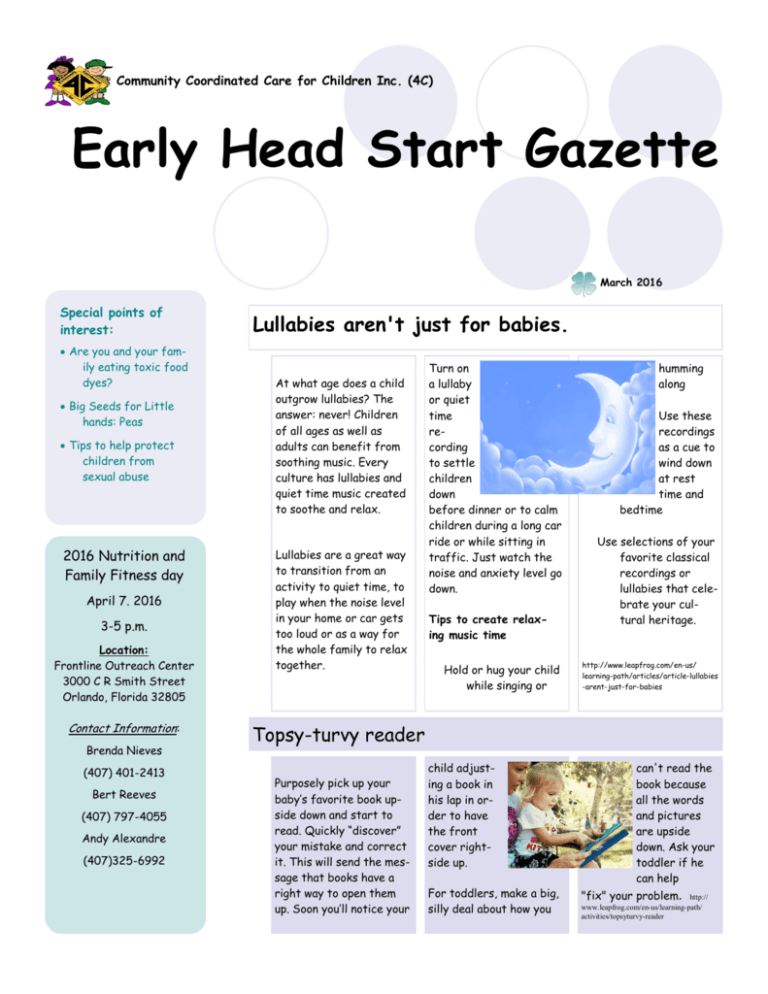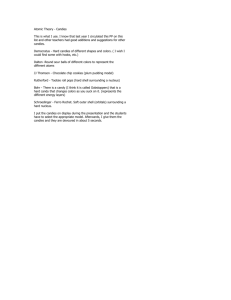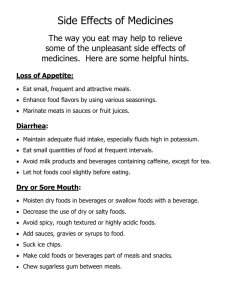Early Head Start Gazette - Community Coordinated Care for
advertisement

Community Coordinated Care for Children Inc. (4C) Early Head Start Gazette March 2016 Special points of interest: Are you and your family eating toxic food dyes? Big Seeds for Little hands: Peas Tips to help protect children from sexual abuse 2016 Nutrition and Family Fitness day April 7. 2016 3-5 p.m. Location: Frontline Outreach Center 3000 C R Smith Street Orlando, Florida 32805 Contact Information: Brenda Nieves (407) 401-2413 Bert Reeves (407) 797-4055 Andy Alexandre (407)325-6992 Lullabies aren't just for babies. At what age does a child outgrow lullabies? The answer: never! Children of all ages as well as adults can benefit from soothing music. Every culture has lullabies and quiet time music created to soothe and relax. Lullabies are a great way to transition from an activity to quiet time, to play when the noise level in your home or car gets too loud or as a way for the whole family to relax together. Turn on a lullaby or quiet time recording to settle children down before dinner or to calm children during a long car ride or while sitting in traffic. Just watch the noise and anxiety level go down. Tips to create relaxing music time Hold or hug your child while singing or humming along Use these recordings as a cue to wind down at rest time and bedtime Use selections of your favorite classical recordings or lullabies that celebrate your cultural heritage. http://www.leapfrog.com/en-us/ learning-path/articles/article-lullabies -arent-just-for-babies Topsy-turvy reader Purposely pick up your baby’s favorite book upside down and start to read. Quickly “discover” your mistake and correct it. This will send the message that books have a right way to open them up. Soon you’ll notice your child adjusting a book in his lap in order to have the front cover rightside up. For toddlers, make a big, silly deal about how you can't read the book because all the words and pictures are upside down. Ask your toddler if he can help "fix" your problem. http:// www.leapfrog.com/en-us/learning-path/ activities/topsyturvy-reader Early Head Start Stick to Naturally Colored Foods for Your Health Your diet should include a range of vibrantly colored foods. These foods should be naturally rich in color. Red bell peppers, purple eggplant, green spinach, blueberries and rainbow chard are all examples of healthy foods whose bright colors are signs of the important nutrients they contain. Are You or Your Family Eating Toxic Food Dyes? Food dyes are one of the most widely used and dangerous additives. While the European Union has recently placed regulations on labeling food dyes to inform consumers of the health risks, the United States has no such requirement. Here are some of the most common food dyes used today, according to the Food Freedom Network: Blue #1 (Brilliant Blue) An unpublished study suggested the possibility that Blue 1 caused kidney tumors in mice. What it's in: Baked goods, beverages, desert powders, candies, cereal, drugs, and other products. Blue #2 (Indigo Carmine) Causes a statistically significant incidence of tumors, particularly brain gliomas, in male rats. What it's in: Colored beverages, candies, pet food, & other food and drugs. Citrus Red #2 It's toxic to rodents at modest levels and caused tumors of the urinary bladder and possibly other organs. What it's in: Skins of Florida oranges. Green #3 (Fast Green) Caused significant increases in bladder and testes tumors in male rats. What it's in: Drugs, personal care products, cosmetic products except in eye area, candies, beverages, ice cream, sorbet, ingested drugs, lipsticks, and externally applied cosmetics. Red #3 (Erythrosine) Recognized in 1990 by the FDA as a thyroid carcinogen in animals and is banned in cosmetics and externally applied drugs. What it's in: Sausage casings, oral medication, maraschino cherries, baked goods, and candies. Red #40 (Allura Red) This is the most-widely used and consumed dye. It may accelerate the appearance of immune system tumors in mice. It also causes hypersensitivity (allergy-like) reactions in some consumers and might trigger hyperactivity in children. What it's in: Beverages, bakery goods, dessert powders, candies, cereals, foods, drugs, and cosmetics. Yellow #5 (Tartrazine) Yellow 5 causes sometimes -severe hypersensitivity reactions and might trigger hyperactivity and other behavioral effects in children. What it's in: Pet foods, numerous bakery goods, beverages, dessert powders, candies, cereals, gelatin desserts, and many other foods, as well as pharmaceuticals and cosmetics. Yellow #6 (Sunset Yellow) Caused adrenal tumors in animals and occasionally causes severe hypersensitivity reactions. What it's in: Color bakery goods, cereals, beverages, dessert powders, candies, gelatin deserts, sausage, cosmetics, and drugs. http:// articles.mercola.com/sites/articles/ archive/2011/02/24/are-you-or-yourfamily-eating-toxic-food-dyes.aspx Big Seeds for Little Hands: Peas Página 2 Peas are easy seeds for kids to handle because they are, well, the size of a pea! They are one of the first crops that can be planted in the spring – as soon as the soil can be worked in the spring or 5-6 weeks before the last spring frost date in your area. Early planting gives cool weather loving peas time to grow before hot summer weather hits. By May it may be too late for spring pea planting in many parts of the country, but you might consider planting in late summer for a fall harvest. Plant peas in mid to late summer about 12 weeks before the fall frost date in your area. If you live in an area where winters are mild, you can plant in fall for a late winter or very early spring harvest. http://www.kidsgardening.org/activity/ big-seeds-little-hands Nutritional Activity at Palm Plaza March 2016 Each month Head Start and Early Head Start children participate in a hands on nutrition activity. These activities provide an opportunity for children to try new foods, work together, develop fine motor skills, and practice a variety of math skills such as counting and measuring. The children in this pictures are making cereal trail mix. They are learning about the grain food group. Announcements Hello Parents! we want to send a THANK YOU to all of the parents and family members that have been engaged and participating in the different activities happening at their sites; whether it is the monthly parent meetings, volunteering in the classroom, or working with your child on the home connections. You all are doing an amazing job! I would like to share with you some of the great things we have coming up in our program. Save the date: April 21, 2016 - Raising the Bar: Parent Appreciation Luncheon. We will be recognizing all of the parents for your participation in our program. Please be on the lookout for your individual invitation. county will be competlike the frosting on a ing to see who will cupcake, it makes it accumulate complete and oh so the most in sweet” -kind and the winner - Unknown will receive a plaque As we and the right to brag, prepare for our parent of course! In-Kind can appreciation luncheon, be accrued through we would like for you all to TAKE PICTURES volunteering in your child’s classroom or with your child as you assisting with activicomplete the HOME ties for the classroom CONNECTIONS and in your home. Home also while you do other Connections are also a activities together. great way to accumuPlease turn these in to late in-kind; please your child’s teacher by take the time to comMarch 15, 2016. We plete these activities will be preparing a with your child every slideshow to showcase night. all that you have been “Parent involvement is doing. IN-KIND WARS will be taking place through March. Each Página 3 Tips to Help Protect Children from Sexual Abuse Fact: Children are most often sexually abused by someone they know and trust. Approximately three quarters of reported cases of child sexual abuse are committed by family members or other individuals who are considered part of the victim’s “circle of trust.” If you know or suspect that a child is being or has been sexually abused, please call the Childhelp® National Child Abuse Hotline at 1.800.4.A.CHILD (1.800.422.4453) or visit the federally funded Child Welfare Information Gateway at: http:// www.childwelfare.gov/ responding. If you need immediate assistance, call 911. Tips to Help Protect Children from Sexual Abuse Teach children accurate names of private body parts. Avoid focusing exclusively on “stranger danger.” Keep in mind that most children are abused by someone they know and trust. Teach children about body safety and the difference between “okay” and “not okay” touches. Let children know that they have the right to make decisions about their bodies. Empower them to say no when they do not want to be touched, even in Educate children Sexual abuse affects many about the difference befamilies. It is estimated tween good sethat 1 in 4 girls and 1 in 6 crets (like surboys are sexually abused. prise parties— non-sexual ways which are okay (e.g., politely because they refusing hugs) are not kept and to say no to secret for long) touching others. and bad secrets Make sure children (those that the know that adults child is supposed and older chilto keep secret dren never need forever, which help with their are not okay). private body Trust your instincts! parts (e.g., If you feel unbathing or going easy about leavto the bathing a child with room). someone, don’t Teach children to do it. If you’re take care of concerned about their own pripossible sexual vate parts (i.e., abuse, ask quesbathing, wiping tions. The best time to talk after bathroom use) so they to your child about don’t have to sexual abuse is rely on adults or NOW.http://www.nctsn.org/sites/ older children default/files/assets/pdfs/ ChildSexualAbuseFactSheetFIfor help. Fast Fact NAL_10_2_07.pdf Everyone’s Special You can learn many things from children. How much patience you have, for instance. ~Franklin P. Jones We're all so much alike...and yet we're all so different! A child's sense of identity grows slowly and for several years isn't likely to be very secure. As children grow, they need opportunities to express their uniqueness, whether in choosing the clothes they want to wear or in developing their unique art projects. There are always times when children need to do what everyone else is doing, but there are also many times when we can support children's selfesteem by helping them carry out their own ideas. -- Fred Rogers http://www.pbs.org/parents/rogers/theme/1686.html








